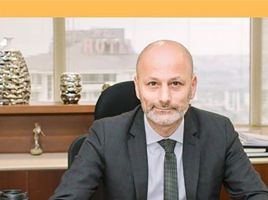Max Wessel was recently appointed SAP Chief Innovation Officer. An interview was held about this new role in SAP. We wanted to share this interview with you about the intimate and interesting information about SAP.

This appointment is the latest exciting step in his career at SAP. In addition to being chief innovation officer (CINO), Wessel leads two of the company’s most important innovation units: SAP Innovation Center Network and SAP.iO Venture Studio.
We sat down with him to understand why corporate innovation is a gargantuan task and to discuss how the company continually works to develop the next generation of innovations to create the SAP beyond tomorrow.
Q: Max, you’ve just been appointed chief innovation officer at SAP. What does that mean to you and how do you interpret your new role?
A: Over nearly five decades, SAP has utterly changed the business world. There wasn’t digitization before there were applications that could tame business process. The opportunity to drive innovation for an organization that’s delivered that type of impact already couldn’t be more exciting. So at my core, I’m just deeply honored and energized to continue the great work of my predecessor and friend Juergen Mueller, who’s stepped into the role of chief technology officer as part of the SAP Executive Board.
Our task is nothing less than creating the SAP beyond tomorrow. To do this, we must maintain a crystal-clear vision of the future and work against it to deliver the products, services, and technical capabilities that our customers need. The sky is the limit if we put that customer focused mission at the center of all our innovative efforts.
How does that vision look?
Our strategy is clear: We are committed to delivering the Intelligent Enterprise. It is up to us to define how this idea evolves over time to serve our customers in the best possible way in the next five to 10 years. With the ever-increasing scale of digitization, ubiquity of smart, connected devices and the complex interdependencies of roles, teams, and businesses, software must be perfectly adaptable to the user’s and an organization’s needs.
We believe the software we deserve is personalized for every situation, works seamlessly across landscapes, and is delivered how we want it. You shouldn’t have to settle for lesser experiences in the office than you would expect of a consumer application. The same simple intuition and flexibility should be available to you. It’s our job to make this vision a reality for our customers.
What makes innovation so difficult for corporations?
Building something new is quite different than improving a mature product. Successful innovators find themselves focusing all of their limited resources on tackling an enormous problem for a small number of people. When you’re dealing with a mature business that’s different. You tend to think about your whole customer base. But innovative products never come to market with the perfect solution. They tend to start crummy relative to the options that are out there. But something about them makes them special for a very small set of customers. Think about Airbnb — staying on someone’s couch wasn’t an appealing idea at first. Years later, that platform gave way to some truly phenomenal experiences that could rival the best resorts.
If you try to solve a problem for everyone, you’ll certainly fail to deliver the perfect solution for the whole market. But everything in a company is designed to optimize the big thing. It’s the “innovator’s dilemma”; the processes that enable them to excel in the market also stifle their ability to build new things. Budgeting, promotion processes, even executive attention causes companies to ignore the small stuff. But it’s the small stuff on the periphery that has the potential to turn into the meaningful stuff of tomorrow.
How does the tech industry generally approach corporate innovation?
The one thing that I’m sure of is that there is no standard. Apple has a very uniform approach for developing new products, Google has all sorts of different units in place that drive experimentation. Each company is considered one of the most innovative of our times. To me, that’s proof that it’s not about the structures and innovation processes inside your company. It’s about ensuring that you build a mechanism that matches the culture of your organization and enables teams to concentrate on addressing the problems your customers face. That approach will look different from organization to organization and be founded in cultural norms when it works.
One of my favorite examples of this is at Google. Inside the company there is something called the “toothbrush test.” It’s a simple question that everyone knows: Can a billion people use the proposed product twice a day? It creates a cultural understanding of what problems are worth tackling. Easy for Googlers to understand and clearly matching their values around scale.
What would be SAP’s toothbrush test?
SAP’s might not be quite as pithy as Google’s. In my current team, we have two organizations in place that are working together in exploring the boundaries of what SAP is willing to do. The technology innovation we explore on the horizon has to have impact across our products. That means that our teams in the SAP Innovation Center Network not only have to tackle tough problems but work on the types of technologies that would be of interest to every developer and partner in our ecosystem, as well as every product owner within our organization. We can’t pioneer technologies that only impact a single industry or business.
When it comes to opportunities to build new products in new markets, SAP.iO Venture Studio brings a second toothbrush test to its process: SAP scale. The smallest business unit at SAP is easily the size of a public company. We should only invest in incubating entirely new applications or services independently if we believe that, if the team were wildly successful, it could support a public company.
Can you give an example of a product passing through these tests?
There is a product we are working on called “Spotlight,” which migrated from SAP Innovation Center Network to SAP.iO Venture Studio this year. It explores the question: Can we apply machine learning against SAP system logs, to better optimize our environment? It’s a very deep technical problem. How do you scan SAP system logs, map them back to SAP processes, and understand whether this sort of process change can be implemented in an SAP customer environment to deliver positive business outcomes? If we could figure out the technology, we were confident it could apply all over.
After it became clear that we could do the system mapping, the team came up with a big idea, which was about automating operational monitoring in a way that made it as easy for a COO to know where to improve as it is for an IT team to identify a system failure. It is a great opportunity for SAP and merited independent commercialization. The team applied for funding from the SAP.iO Venture Studio after proving they could tackle the technical challenges. They are now working away in Berlin to make this a reality for our customers everywhere.
How does SAP approach co-innovation with customers?
SAP is the company entrusted to manage many of the most complex problems in business. For that reason, we need to work right alongside our customers and our end users. We cannot ship changes into production the way Facebook does and see how users react. There is too much at stake. We need to work with our customers to think through dependencies when implementing changes. The good news is that SAP figured out how to do this a long time ago.
The most innovative teams at SAP are highly selective about the customers they work with in the market. We love engaging early adopters who want to undertake experimentation with us. The better the alignment between our teams and our customers, the faster that we can accelerate through process.
Do you notice that corporate research and development (R&D) is undergoing a change toward more openness and growing flexibility? If so, what are the indicators?
Yes, 100%. In the middle of the last century, corporate R&D looked like university research. Today, two things have changed. The first is that the cost of experimentation, specifically in digital businesse,– has dropped precipitously. The second change is that there is now more capital than ever being accessed by small companies. With those changes, it becomes easier for people outside the walls of a large organization to build transformative products. If you want to tap into that collective brainpower you have to be more open in nature. There’s no fighting it, only missing out.
ERP Pricing: Get 2019 pricing on 45 different ERP systems. Click to download your free guide.





